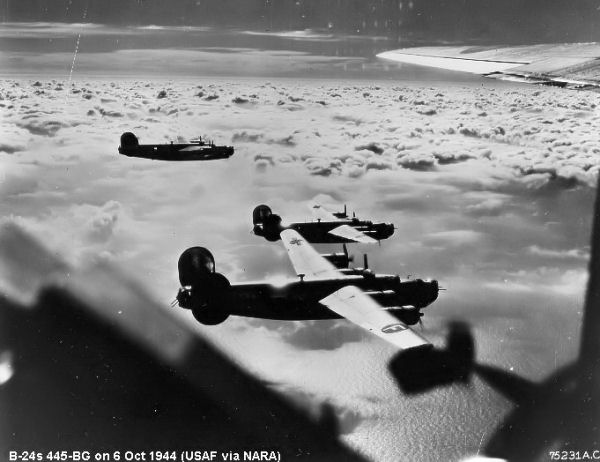Earl Doggett’s Military Diary
Staff Sgt. Earl Doggett
“Diary Away From the States”
November 15, 1943 – January 30, 1944
(NOTE: I edited spelling, punctuation, and corrected some location details. I also found online period photos to illustrate some places and make his diary more visually interesting. A few statements aren’t clear to me, but this is exactly how Earl wrote it. –Charlie Doggett, 2014)
Nov. 15, 1943 – I left Morrison Field, West Palm Beach, Fla.
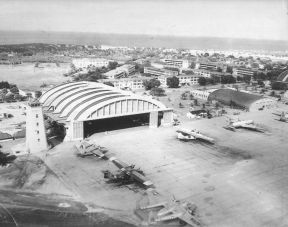
Nov. 15, 1943 – I landed at Borinquen Field, Puerto Rico (later Ramey AFB). Our barracks were like concrete hotels.
Nov. 16, 1943 – Left Borinquen and landed at Atkinson Field, Georgetown, British Guyana (also spelled Guiana) in South America. The natives were like the natives of Puerto Rico (but not Spanish). We start using mosquito nets at next stop. Hope I don’t get bit. British money is used here. I send Agnes a 4 pence bracelet. They don’t have a 4 pence in circulation in Britain. (3 pence and 6 pence there).
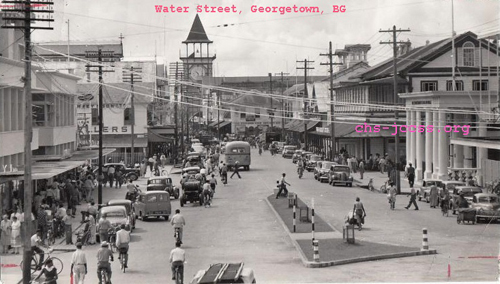
Nov. 19, 1943 – We left Guyana and landed at Belem Field, Belem, Brazil. Natives are friendly. I try to speak Spanish to them and it isn’t quite theirs. They speak Portuguese. There were Navy PBY’s here, the floating airplanes.

Nov. 20, 1943 – We left Belem and landed in Natal, Brazil. We have open air theater and lots of fruit (pineapple, bananas, and oranges) and food in general was good. We pull 25 hours on our ship.
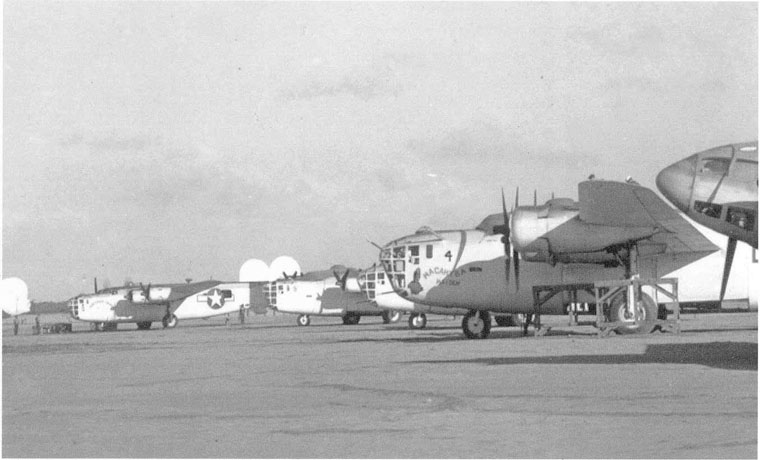
Nov. 22-23, 1943 – We start a night flight across the Atlantic. Radio prevents us. Nov. 23rd we leave Natal at 2300. We have a tropical storm for 400 miles of flying.

Nov. 23, 1943 – Landed in Dakar, Senegal, West Africa. There are Arabs here and they wear long dress-like clothes, some very ragged. One wore a G.E. Barracks Bag. There were French girls and we saw a well-dressed Frenchman in black hat and light coat strangely combined with shorts and sandals.

Nov. 24, 1943 – We leave and land in Marrakech, French Morocco. A pass to town. American Red Cross has a nice building. They took it over from French who were building a gambling place at start of war.
Nov. 24-25, 1943 – We crossed over and between the Alps. At 14,000 ft. and air field is in sight. We don’t think we can make the next hop without being pursued. One ship has just aborted with one JU 88 shot down. Leave for England on night flight. Landed and settled down in England for Thanksgiving, Nov. 25th, 1943. Dinner in air at low formation over England.
Nov. 26 – Dec. 10, 1943 – Schooling
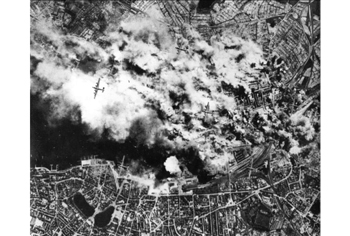
Dec. 13, 1943 – We make the first mission of our group and squadron. Kiel, Germany is the target. N.W. Germany has the second largest boat yards and large underground ammo. Storage. There are a large number of fighters and heavy flak to expect. No fighters except allies. Many puffs of flak. 5,000 lb. incendiary bombs load.
Undercast. (“undercast” means: A cloud layer of ten-tenths (1.0) coverage as viewed from an observation point above the layer; the term is used in pilot reporting of in-flight weather conditions. Can’t see the ground from plane because of low clouds.)
Pathfinders are pattern bombing.
Dec. 17, 1943 – The 20th Group bombs Bremen, Germany. They don’t let us fly. It is most important naval yards in Germany with railway junction. 25 bombers and 6 fighters, the last one B. from 700th.
Dec. 22, 1943 – We raided Osnabruck, Germany. Three libs. in group lost. 703rd loss none. A lib. Collided with us, cut hole in wing and ruined #1 prop. Something wrong with other pilot or ship. (I get ready to bail out, terrible shake).
Lt. Metcalf flies back to leading our element after losing altitude. It is undercast and Pathfinder is pattern bombing. FW. 190 come in. Flak very light. We lose around 25 bombers. No loss in my squadron yet. 3 lost in group.
Target railroad junction. Photos take 1 hour later and blazes seen. Bombing poor. One ship came back and landed with one engine nose wheel and one landing gear at some place in England, threw out dead navigator.
Dec. 24, 1943 – Christmas Eve. Buddies raided by 12,000 ft. precision, pattern bombing of rocket factory in France. Milk run. Secret and bombs away at corn field outside little town.
Dec. 25, 1943 – No mission. Day off to eat turkey.
Dec. 29, 1943 – Buddies raided pathfinders. One ship missing from group and it from 703rd. Nothing brewing with us. We go to Norwich, spend the night at Central Hotel.
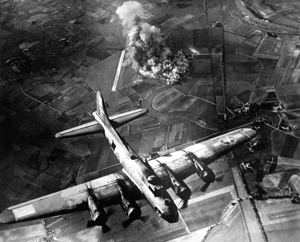
Dec. 30, 1943 – One ship lost by ditching is all. Berlin was raided last night and all day by R.A.F.
News just came out about our destruction in Kiel. Fires still burning and 17 days has past. It has been quiet, but the place caught hell!
In behalf of friends missing today, we all hope to carry on their part. Germany is down and a second front invasion is being launched very soon. My guess is on the coast of Southern France. Forces striking from England.
Dec. 31, 1943 – Jan. 1, 1944 – New Year’s Eve, then we are awaken at 3 AM after getting an hour’s sleep. We take off before dawn and come back at dusk. We carry 2700 gallons of gas and 5,000 pounds of demo. We go by GPS to blast airfields in Southern France. I watch the hangars blow sky high from ball turret. We raided two targets instead of one. Dangerous for fighter opposition. One B 024 blew up with us, but my group didn’t lose an aircraft. 17 bombers and 5 fighters missing from 8th Air Force.
I believe these attacks are all over France and is for the invasion. Hope so. We flew 9 hours and 15 minutes (says newspaper clipping.)
Jan. 4, 1944 – Buddies raided Kiel, Germany and a key shipbuilder.
Jan. 5, 1944 – We bombed Kiel, Germany again. I was last over Kiel Dec. 13, 1943.
We got up at 1:30 AM and visibility is good. Target busted. White, crystal like sand throughout the country. Small towns and railways resemble England’s.
Flak puffs big, but scattered. We didn’t get a hit. Heavy at target. One big ship shot gray looking shots at us. The ship was in harbor north of Kiel. We couldn’t see our fighter cover. They were likely with bombers deep into Germany.
I am grounded. Ear trouble, sore throat.
Jan. 6, 1944 – Mission scratched.
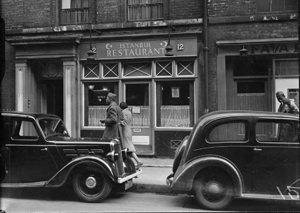
Jan. 10, 1944 – I get out of ward from cold and fever. I go to London by myself with a 48-hour pass. I find Hans Crescent Club and get a bed. I get a buddy and we go to Piccadilly Circus. At 10:30 we catch underground train back to bed. Good night sleep.
Jan. 11, 1944 – I woke up, took a bath, breakfast. I find taxicab with 4 others to make a 40 mile tour of London, seeing 32 special places. We first go to Buckingham Palace. The king has spent two nights there. Eleanor Roosevelt has spent 8 nights there. Outside the palace are architectural monuments as a gift of New Zealand, including the Queen Victoria Monument. She reigned 60 years, the longest. Close by we see the Wellington Barracks, very large and soldiers are known to get the toughest of training there. (20 mile hop, etc.)
We see Westminster Abbey and many different chapels and the cathedral. We saw the coronation chair for all kings and queens. All are crowned in this solid gold chair, weighing 14 tons. Important poets are at rest here as well as high ups. Some include Neville Chambers, Charles Robert Darwin, and Longfellow.
Westminster is one section and London has other sections. Next we visit the House of Parliament. The interesting thing from outside is the clock named Big Ben. Its big hand is 15 ft. long and short hand is 9 ft. long. It takes 3 men 7 days to wind Big Ben.
Downing Street is guarded more than Buckingham Palace, since the Prime Minister lives here and Anthony Eden is another place, a short street.
Thanks to our taxi driver who knows everything and does this every day. We also see Cleopatra’s Needle, built in 1500 B.C. All Hollow’s Church was the oldest church standing in the world until a German bomb hit and flattened it. It was built in 675 A.D. We cross the London Bridge and the Tower Bridge. We see the mansion of the Lord Mayor of London and Wall Street. (?)
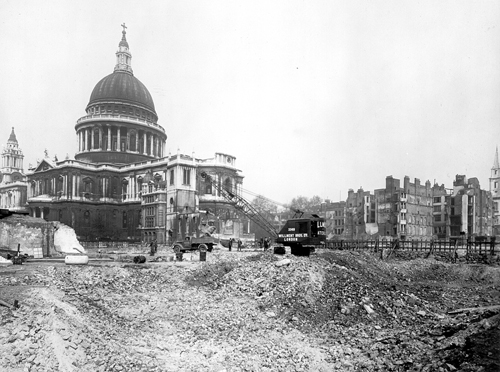
We see and go through St. Paul’s Cathedral. 650 steps to the Whispering gallows. I saw the solid gold eagle, supposedly bringing the United States and Great Britain, weighing one ton. (Not very big either.) The center of London is in the center of the church and I stood in it. A bomb went through the concrete floor and didn’t go off. They dug it out. It was a thousand kilocycle bomb (about 15000 lbs.). Military personnel are also buried here. I saw the place the first American was put away that died in the Battle of Britain in 1940, by name of Lindsley, an R.A.F. Pilot.
I saw the burial place of Florence Nightingale, the first to offer First Aid and Arthur Duke of Wellington in a 16 ton vault. There was a chapel of Knights and about 6 other chapels. I saw the German Embassy. After they were run out of England they found short wave transmission sets in the walls. There was also Kent House, home of the Duke of Kent, probably the richest duke. St. James Palace is where the Duke of Windsor once lived. He got Wally Simpson and thereby missed the throne of King.
Jan. 12, 1944 – While in London my buddies raid Central Germany. My group turns and bombs small cities and don’t get 2 aircraft factories. Heavy fighting and losses. 59 bombers were lost, over 100 enemy shot down. Heavy damage on 3 airplane factories and small cities. Weather got too bad for flying. We 445 Group didn’t lose a plane.
Jan. 16, 1944 – We are briefed and almost get dressed for the toughest mission of the war thus far, Boy Hi. Mission scratched as fog was closing in. Fair weather otherwise. The target was Gotha, Germany, a Me. 190 Engines Factory, producing half of total German supply.
Jan. 19, 1944 – Fog and rain keeps us on the ground.
Jan. 20, 1944 – Scratch mission to Gotha, France. ( I think he meant Gotha, Germany.) I got dressed to go as an extra, but fog closes fields in.
Jan. 21, 1944 – My crew bombed rocket installations outside Bonares, France. It was a “Milk-run,” 6 times over target, partial cloudiness. We were targeting rockets aimed at London. This is my 5th mission and I get the Air Medal. Flak is becoming extremely heavy in certain areas in Northern France.
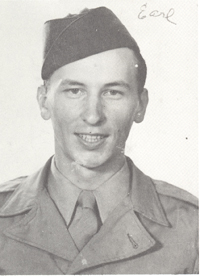
Jan. 28, 1944 – Dewey and I are on a 2-day pass. We stop at London and go on to Bristol. We have a nice night and find his wife’s relatives. They are nice, name is Cook at 38 B Road. They live close to the Bristol Aircraft Factory.
Jan. 29, 1944 – We leave for London on an air raid. Three Gerries (slang for Germans) are shot down. We got the heaviest barrage of flak every put up so far. I saw one flare dropped. No bombs fall close to us in center of town. My buddies made a new bombing record on Frankfort.
Jan. 30, 1944 – Buddies bombed Brunswick. We lose one plane, but another squadron was flying it.
That is all of Earl’s diary.
Staff Sgt. John H. Robinson was in a different crew in Earl’s squadron or group and wrote the following for Earl’s family, I assume as a conclusion to his special WWII Military Diary:
Feb. 4, 1944 – Staff Sgt. Earl Doggett went down on an operational mission into France. The weather that day was so sloppy that even ducks shouldn’t fly in it. Their mission was only a short distance into France and should have been an easy mission if it hadn’t been for the weather.
As far as we know, their ship crashed into another ship over the English Channel, for visibility was very poor and the sky was full of planes.
Later, about March, there was something said about part of his crew being washed up on the English coast and if this is true, then he must have crashed into the English Channel and the first report must have been right.
I imagine the General has notified his family and given all the details, but this may help a little and even though it is likely he is dead, it is theoretically possible for him to be alive and in Germany.
Our crew lived in the same barrack with his crew and he was a swell and well-liked fellow. On his final mission my crew was on a pass and did not fly with them.
More can be read about Earl in John Robinson’s book, A Reason to Live. Or see my excerpts from the book as one of the subpages here titled Earl’s Last Days Detailed which is an incredible story by one of his bunkhouse buddies!
There is also a lot about his first plane and his crew in the book Nine Yanks and a Jerk by Scott Culver who also had a relative on the plane. This link is to my page about the book where you can also find a link to Amazon.com to purchase the book if interested.


